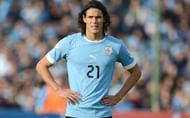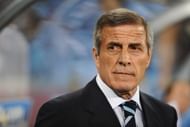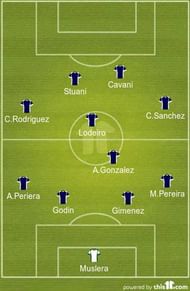Uruguay enter the 2015 edition of the Copa America as the defending champions and one of the favourites despite missing their talismanic player Luis Suarez. And they do not seem to have the same spark about them as they did four years ago. Back then, Uruguay riding on an unexpectedly strong showing at the World Cup the summer before, swept aside opponents in the continental tournament where the talented attacking trio of Edinson Cavani, Luis Suarez and Diego Forlan played a crucial role in Uruguay’s Copa American success.
However, Uruguay are in the process of rebuilding as players like Diego Forlan have retired and new faces are being inducted into the team. Since the 2014 World Cup, coach Oscar Tabarez has given debuts to nine players. Seven of them have made the squad for the Copa. La Celeste have made been impressive in the run-up to the tournament but the competitive group matches will be a different affair.
Even with all the troubles on and off the pitch, La Celeste will not be giving up the trophy without a fight.
Squad
Uruguay will be without the services of the mercurial Barcelona striker Luis Suarez, who is still suspended from his infamous World Cup biting incident. However, even without Suarez’s services, Uruguay can still rely on the enigmatic Edinson Cavani who comes into the tournament on the back of a 30 goal season in France.
Considered as one of the best in La Liga, Diego Godin will have to play a pivotal role in shoring up the defence if Uruguay are to defend their title. Godin (88 caps) and Maxi Pereira (101 caps) form what is perhaps the most experienced, major competition-tested defences in the tournament. Tabarez has decided to field relatively fewer defenders for this tournament which might prove costly if there are any injuries.
In midfield, the creativity of Nicolas Lodeiro and the pace and trickery of Carlos Sanchez will be an important asset if Tabarez decides to counter attack teams. As always, the pair of Alvaro Gonzalez and Lodeiro will be crucial in protecting the back four as well as maintaining the shape of the midfield. Tabarez has also rewarded many youngsters, notably exciting striker Diego Rolan, for their fine performances with their inclusion in the national squad.
Goalkeepers: Fernando Muslera (Galatasaray), Martin Silva (Vasco da Gama), Rodrigo Munoz (Libertad)
Defenders: Maxi Pereira (Benfica), Jose Maria Gimenez, Diego Godin (both Atletico Madrid), Sebastian Coates (Liverpool), Gaston Silva (Torino)
Midfielders: Alvaro Pereira (Estudiantes), Mathias Corujo, Guzman Pereira (both Universidad de Chile), Jorge Fucile (Nacional), Alvaro Gonzalez (Torino), Carlos Sanchez (River Plate), Egidio Arevalo Rios (UANL Tigres), Nicolas Lodeiro (Boca Juniors), Cristian Rodriguez (Atletico Madrid)
Forwards: Giorgian de Arrascaeta (Cruzeiro), Christian Stuani (Espanyol), Abel Hernandez (Hull City), Edinson Cavani (Paris St Germain), Diego Rolan (Girondins Bordeaux), Jonathan Rodriguez (Benfica)
Best Starting XI (4-4-2): Fernando Muslera; Maxi Pereira (Benfica), Diego Godin, Jose Maria Gimenez, Alvaro Pereira; Nicolas Lodeiro, Alvaro Gonzalez, Carlos Sanchez, Cristian Rodriguez; Christian Stuani, Edinson Cavani
Coach
Since Oscar Tabarez has taken over Uruguay for a second spell in 2006, Uruguay have reached the semi-finals of the 2007 Copa America, the semi-finals of the 2010 World Cup and won the Copa America in 2011. Even though they had a disappointing World Cup in Brazil last year, Uruguay still managed to upset European teams like England and Italy en-route to their Round of 16 exit.
Tabarez has played an important role in Uruguay’s remarkable progress in the past decade. He has played an important role in revamping the Uruguayan youth system trying to bridge the gap between the outgoing and incoming stars of Uruguayan football. El Maestro has become more pragmatic with his tactics over the past few years and has his work cut out as the squad is average compared to the 2011 team.
“Our expectations are very particular, generally low profile since we never consider ourselves favorites for anything and this Copa America is very difficult.” – Tabarez
Formation and Tactics
Tabarez will most likely stick to the 4-4-2 diamond formation that has brought him tremendous success over the years. Due to the unavailability of Luis Suarez, Tabarez might be reluctant in going for a 3-man attack that wreaked havoc in 2011.
The midfield will be marshalled by Alvaro Gonzalez and Lodeiro. They will be responsible for controlling the centre of the park and dictating the overall play when in possession. The back four remains more or less the same from last year’s World Cup.
The high-profile absentee remains the former captain Diego Lugano who has been overlooked for this tournament. Gimenez, who proved to be an able replacement at a crucial juncture following Lugano’s injury in Brazil, will retain his position in the center of defence.
Maxi and Alvaro Pereira, the attacking full backs will provide the necessary overlapping runs during the transition from defence to attack. Both are defensive minded fullbacks which will be important when Uruguay look to shut out matches. Carlos Sanchez will be deployed on the wing and much will be expected of him due to his fine showing for River Plate this season.
In attack, a lot will depend on the whether Cavani can extrapolate his club performance at a major tournament for La Celeste. With an ability to provide movement and direct linkup play with the attacking midfielders, chances will fall Cavani’s way. Whether he is clinical in front of goal remains to be seen. After a rather mediocre World Cup, Cavani would want to silence his doubters once and for all at the Copa America.
History at Copa America
Uruguay are the most successful team in this tournament finishing champions 15 times. Called the South American Championship Era between 1916 and 1967, Uruguay won the championship 11 times i.e. in 1916, 1917, 1920, 1923, 1923, 1926, 1935, 1942, 1956, 1959, and 1967. They have been crowned champions four times in the Copa America era in 1983, 1987, 1995 and 2011. Uruguay has also hosted the tournament eight times.
Uruguay has gate crashed Argentina’s party when it won the 1987 and 2011 tournaments, both held in Argentina. In 2011, Uruguay beat Paraguay in the final to clinch the trophy after 16 years. Luis Suarez was named the man of the tournament with four strikes including one in the final.
This is a competition where La Celeste are the most competitive and at their best.
| YEAR | RESULT |
|---|---|
| 1975 | Fourth Place |
| 1979 | Group Stage |
| 1983 | Winners |
| 1987 | Winners |
| 1989 | Runners-Up |
| 1991 | Group Stage |
| 1993 | Quarter Finals |
| 1995 | Winners |
| 1997 | Group Stage |
| 1999 | Runners-Up |
| 2001 | Fourth Place |
| 2004 | Third Place |
| 2007 | Fourth Place |
| 2011 | Winners |
Predictions
Uruguay is drawn in Group B along with Argentina, Paraguay and Jamaica. It’s a relatively easier group to be in the tournament as apart from Argentina, Uruguay faces minimal competition from the other two.
However, their path could be complicated if they finish second in the group, meaning they could end up facing either Colombia or Brazil in the next round. If Uruguay manage to stun Argentina and finish as group winners, it would set up a match with a third-placed team from Group A or Group C, which would likely be one of Ecuador or Venezuela, both beatable for Uruguay.
Once La Celeste reaches the semi-final, anything is possible. A dogged defence and a will to retain the trophy would be factors that might make it tough for any opponents. Keeping in mind the struggles of the team and the rebuilding phase a semi-final finish would be a huge achievement for Tabarez’s men.
Final Prediction: Uruguay will be eliminated in the semi-finals and will finish fourth



